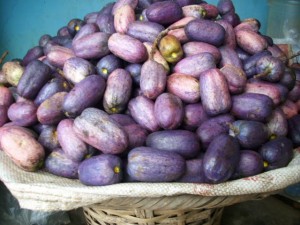 Native to the humid, tropical forests of West and Central Africa, safou (Dacryodes edulis) is also known as the “butterfruit” for its rich, oily pulp. But safou is more than just creamy and delicious. It’s quickly becoming an important cash crop for small farmers in Africa and has proven useful in agroforestry systems and in preventing hunger.
Native to the humid, tropical forests of West and Central Africa, safou (Dacryodes edulis) is also known as the “butterfruit” for its rich, oily pulp. But safou is more than just creamy and delicious. It’s quickly becoming an important cash crop for small farmers in Africa and has proven useful in agroforestry systems and in preventing hunger.
People in West and Central Africa have been eating safou for centuries as a fresh fruit between meals and cooked as a main course. When roasted or quickly boiled in salted water, the pulp separates from the skin and seed and takes on a buttery texture. In Nigeria, cooked pulp is combined with starchy foods like maize to make a main course. And if cooked for even longer, a healthy oil, primarily made up of unsaturated fats, can be extracted from the pulp and seed.
Like its namesake, butter, safou is high in fats and very calorie-dense. But unlike butter, safou is also high in amino acids, the chemical building blocks of proteins. Concentrations of some its essential amino acids, such as lysine and leucine, are comparable to concentrations found in eggs and meat. Plus, the fruit is also high in micronutrients and minerals, particularly potassium, calcium, and magnesium, makingsafou a superfoodwith the potential to help alleviate hunger and malnutrition.
Aside from producing nutritious fruits, safou trees also yield a variety of other products. Its wood is stiff and elastic, making it useful for tool handles. The bark produces a resin that makes both a glue for mending pottery and topical treatment for jiggers, a parasitic flea that embeds itself in the skin. And the leaves and roots are also found in a variety of traditional medicines used to treat everything from dysentery to joint pain.
Given their many uses, safou trees are highly coveted in West and Central Africa. Farmers and smallholders go to great lengths to cultivate wild seedlings and protect them from being removed. But despite its popularity, safou is still not widely domesticated or commercially produced. But over the past ten years, researchers and non-profit groups have realized its usefulness and begun endorsing it as a viable new crop.
The World Agroforestry Center has been promoting it as a key tree species in agroforestry systems that can be intercropped with food crops to provide shade and biomass while also producing edible fruit. And the UK-based International Centre for Underutilised Crops has been searching for varieties that combine high-quality taste, nutrition, and disease-resistance.
This recent interest in safou has led to a proliferation of safou plantations in Africa and serious efforts to domesticate and breed varieties for commercial use. Fruits are sold at local markets and the oil is extracted for use in both cooking and natural cosmetics. Safou has even gained popularity in European markets where immigrant communities are importing the fruit in large quantities.
High in calories and nutrients, safou is a food that could prove useful in reducing hunger and malnutrition, and the tree’s many other uses make it a practical option for small farmers in Africa.
Guest post by Dan Kane.

Danielle Nierenberg, an expert on livestock and sustainability, currently serves as Project Director of State of World 2011 for the Worldwatch Institute, a Washington, DC-based environmental think tank. Her knowledge of factory farming and its global spread and sustainable agriculture has been cited widely in the New York Times Magazine, the International Herald Tribune, the Washington Post, and
other publications.
Danielle worked for two years as a Peace Corps volunteer in the Dominican Republic. She is currently traveling across Africa looking at innovations that are working to alleviate hunger and poverty and blogging everyday at Worldwatch Institute’s Nourishing the Planet. She has a regular column with the Mail & Guardian, the Kansas City Star, and the Huffington Post and her writing was been featured in newspapers across Africa including the Cape Town Argus, the Zambia Daily Mail, Coast Week (Kenya), and other African publications. She holds an M.S. in agriculture, food, and environment from Tufts University and a B.A. in environmental policy from Monmouth College.








